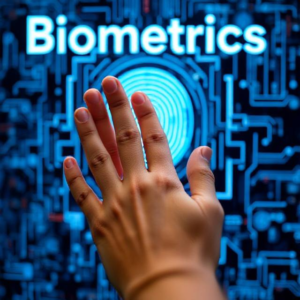1. What is Biometrics?
Biometrics is a way of using your unique physical or behavioral traits to identify who you are. It’s like how your fingerprint or face is one-of-a-kind to you—no one else has the same! Biometrics measures those characteristics to confirm your identity.

Some common biometric traits include:
- Fingerprints: The patterns on your fingers.
- Face recognition: The unique shape and features of your face.
- Iris or retina scanning: The unique patterns in your eyes.
- Voice recognition: The distinct sound of your voice.
- Hand geometry: The shape and size of your hand.
- Fingerprint scanning and facial recognition are the most common forms used today.
Biometric systems work by taking a scan of one of these traits and then comparing it with a stored version of your data (like your fingerprint or face scan in a database). If they match, you’re verified, and access is granted.
2. What is Authentication?
Authentication is the process of proving who you are. It’s like when you enter a password or use your fingerprint to unlock your phone—it’s your way of showing that you’re the authorized person.
In traditional systems, authentication is usually done with something you know (like a password) or something you have (like a keycard). But with biometric authentication, it’s something you are—your unique physical or behavioral trait.
3. Biometric Authentication Systems:
Biometric authentication is a type of system that uses biometrics to verify a person’s identity. Here’s how it works:
Step-by-Step Process:
- Enrollment: First, you register your biometric data. For example, when you first set up your phone’s fingerprint scanner, you scan your fingerprint a few times so the system can remember it.
- Verification: Later, when you try to unlock your phone or access a secure area, the system scans your finger (or face, etc.) again.
- Matching: The system compares the scan to the stored data (the one it saved during enrollment). If it matches, you are authenticated and granted access.
Types of Biometric Authentication:
- Fingerprint Scanning: Your fingerprint is scanned and stored. When you place your finger on the scanner again, it checks if it matches the stored pattern.
- Facial Recognition: Your face is scanned and stored in a system. Next time, the system checks your face against the stored data to make sure it’s you.
- Iris Scanning: The unique pattern in your iris (the colored part of your eye) is used to identify you. It’s considered highly accurate.
- Voice Recognition: Some systems use the sound and rhythm of your voice to confirm your identity.
4. Advantages of Biometric Authentication:
- Convenience: You don’t have to remember passwords or carry keys. Your body is the key!
- Security: It’s much harder for someone to fake your fingerprint or face than to guess a password.
- Speed: Biometric scans (like fingerprints or face scans) are quick—usually just a second or two.
5. Where Do We Use Biometric Authentication?
- Smartphones: Unlocking your phone using a fingerprint or face scan.
- Banking: Some banks use fingerprints or face recognition to access your account.
- Airports: Instead of showing your passport, some airports use facial recognition to speed up check-in and boarding.
- Security Systems: Offices or buildings may use fingerprint scanners to control who enters certain rooms.
6. Challenges of Biometric Systems:
- Privacy concerns: Since biometrics are unique to you, if someone steals your biometric data (like a fingerprint), it’s hard to change, unlike a password.
- Accuracy: Sometimes the system might not recognize you, especially if the sensor isn’t very good or if your finger is dirty or injured.
- Cost: Biometric systems can be more expensive to set up than traditional password-based systems.
7. How Biometric Authentication Compares to Other Types of Authentication:
- Something You Know (Password/PIN): If someone finds or guesses your password, they can access your account. But biometrics are harder to steal.
- Something You Have (Keycards, Phone): If you lose your keycard or phone, someone might be able to use it to gain access. But biometrics can’t be lost or stolen in the same way.
In Simple Terms:
- Biometrics is about using your unique body traits (like your fingerprint or face) to identify yourself.
- Authentication is the process of proving that you are who you say you are.
- Biometric authentication systems use things like your fingerprint, face, or voice to make sure it’s really you trying to get into something, whether it’s your phone, bank account, or a secure building.
Tags: access control, airport facial recognition, authentication comparison, authentication methods, authentication technologies, authentication technology., banking biometrics, behavioral traits, biometric accuracy, biometric authentication, biometric challenges, biometric control systems, biometric cost, biometric data, biometric devices, biometric encryption, biometric identification, biometric matching, biometric privacy, biometric protection, biometric scanners, biometric security, biometric sensors, biometric systems, biometric traits, biometric verification, Biometrics, convenience of biometrics, cyber security, enrollment process, face ID, facial recognition, fingerprint scanning, hand geometry, identity theft prevention, identity verification, iris scanning, keycard authentication, multi-factor authentication, password alternatives, password-based authentication, personal identification, physical traits, retina scanning, secure access, secure login, secure systems, Security Systems, smartphone biometrics, something you are, something you have, something you know, technology in security, touch ID, unique body traits, user authentication, user verification, verification process, voice biometrics, voice recognition


